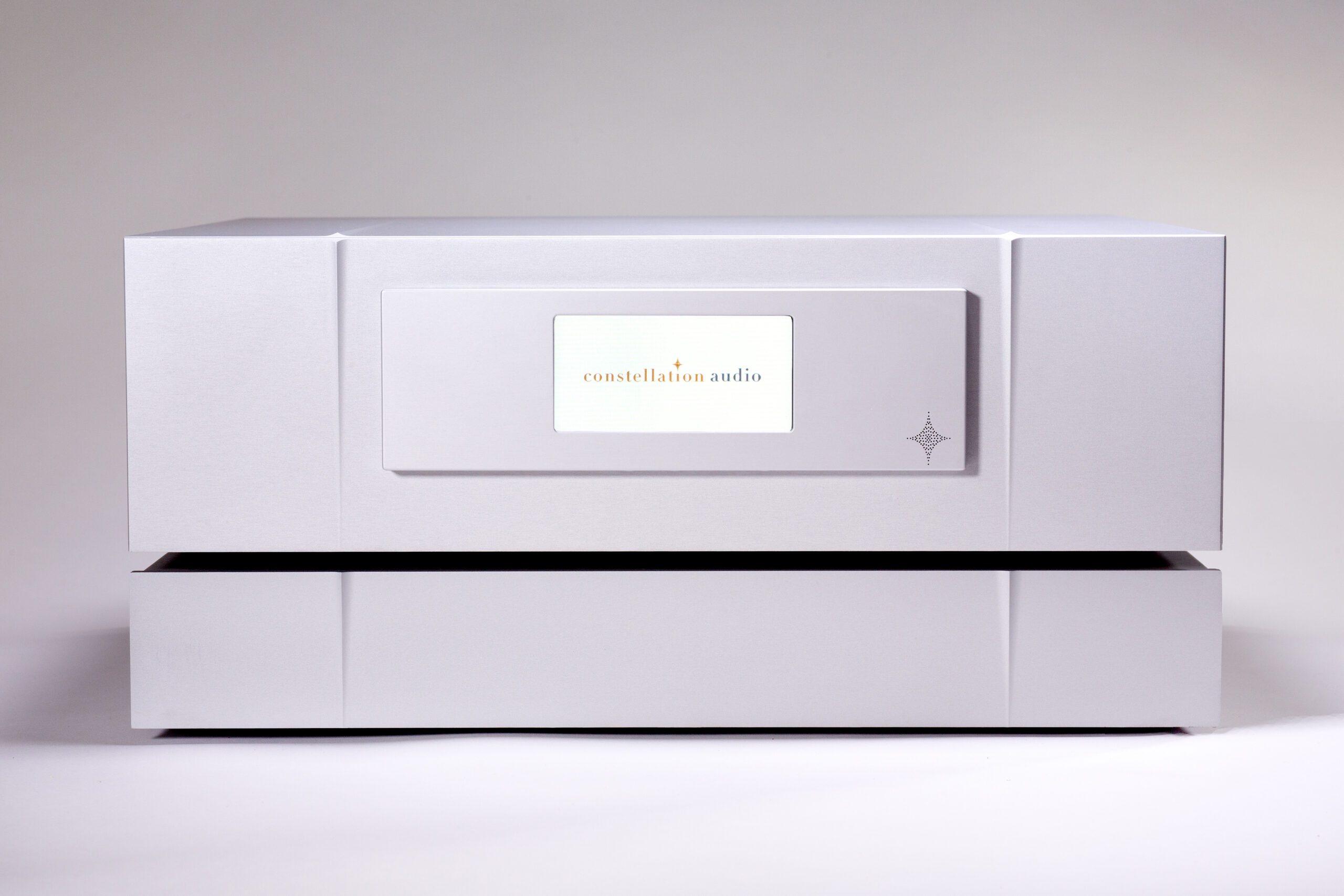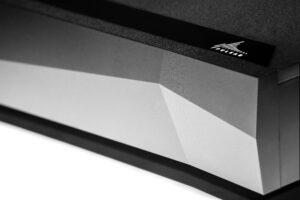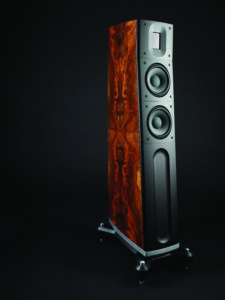
It’s hard to overstate the significance of Constellation Audio’s product lines. The company was created to give the best engineers in their respective fields a blank canvas. This meant the greatest living preamplifier designer, the finest power amplifier engineer and so on can build their dream projects. That’s why there’s no-one better qualified than John Curl to design Constellation Audio’s Andromeda phono stage from the brand’s Revelation series.
John Curl’s dream phono stage was the discontinued Orion from the company’s Reference Line. Orion laid the foundation for later equalisers that fretted the same firmament. The two-box Revelation Series Andromeda is one of the brightest phono stage stars in the audio heavens. Andromeda sits below Constellation Audio’s present top phono equaliser, the Perseus from the Performance line (tested here). However, this vinyl supernova aside, Constellation Audio’s Andromeda is simply one of the best.
One box good, two boxes better
And, like all the best phono stages, Andromeda is divided into the phono stage itself and its power supply (you can add a third DC filtration box, but we went with the standard two-chassis Andromeda). Three separate leads connect Andromeda to its juice box; one for each channel and one for the logic control. Both chassis arrive in the same box, so the power supply isn’t a cost upgrade. This makes the Andromeda box ‘heavy’ for a phono stage. Still, everything about Andromeda is built big and those solid, beautifully finished aluminium chassis panels are deliberately thick to help ward off electromagnetic and radio frequency interference. So, ‘heavy’ is a given.
Built big, for example, extends to the number of cartridges you can run at any one time. The Andromeda can handle four different cartridges, split between two XLR and two phono inputs, each with their moving coil and two moving magnet options. This might seem excessive, but record-playing enthusiasts are in a literal ‘arm’s race’; the cognoscenti can no longer ‘make do’ with just two arms, as they now need at least two for different performance cartridges. Given some listeners use a classic Ortofon SPU, a state-of-the-art Audio-Technica or Dynavector, a hand-woven by samurai limited edition jewel of a cartridge and a design specifically for mono use, four inputs isn’t beyond the pale anymore.
Moving Magnet cartridge uses are often short-changed by high-grade phono stages, but not here. Alongside a small knob for adjusting MC resistive loading, there is a DIP switch array on each channel that allows MM capacitive and resistive loading adjustment. The reason why there aren’t two sets of DIP switches becomes clear when you use the front panel; the MC load for both channels is adjustable in one-ohm steps and that loading is displayed on the one of the sub-menus on the front screen. MC gain (high/low, not specified) is also adjusted using the front panel.
The logic-controlled display is a refined black-on-white touchscreen with the sort of readability of a Kindle Paperwhite. The display stands proud of the main body of the Andromeda and this looks good, but it’s not simply for decorative purposes; beneath the touch screen are five hard buttons, controlling basic functions like ‘mute’ and some menu navigation. There’s a learning curve with the combination of hard buttons and screen, and this – coupled with its deliberate slowness of – will lead to some touch-screen button mashing until you learn Andromeda’s pace.
Modular approach
The key to Constellation Audio’s success is its inherently modular approach. Input and gain stage modules are shared with other products in the line (the Pictor line stage in the same range being the most obvious partner). They are also suspended boards, to reduce the potential for vibration undermining sound quality. These modules are met by an RIAA equalisation circuit of incredible accuracy, sticking to the EQ curve like a very sticky thing covered in glue and gaffer tape. This fits well with John Curl’s ‘platonic form’ or ‘archetype’ of a phono stage.
However, a collection of products made by different ‘dream team’ designers could be prone to sounding messy. Fortunately, Constellation Audio factored in common design goals such as a fully-balanced output stage built with low-noise FETs. The company also built a dual-mono power supply in its separate chassis for Andromeda. These elements could be considered ‘commonality of purpose’ and ensures consistent sound across Constellation Audio’s devices.
Regarding products from electronics brands, phono stages and DACs have a dual role. When ‘preaching to the choir’ (such as using the Andromeda in an all-Constellation Audio replay chain), the product needs to reflect and enhance the performance of the existing equipment. However, these devices often act as ‘ambassadors’ or even ‘gateway’ products in a more mixed system. If they do their job properly, they help make the user a prospective owner of more products from that brand. If they don’t, it’s unlikely that the brand will be considered again. Fortunately for Constellation Audio, the Andromeda is one hell of an ambassador.
Actively calm
It sounds like a contradiction, but the Andromeda has a strong sense of ‘active calm’. By this, I mean the sound quality is so remarkably accurate you stop listening to the electronics and listen to the recording, which quickly brings a sense of calm to your listening sessions. Continuing with the contradictions, that applies as much to edgy, spiky and raw punk and rock music as it does listening to some smooth jazz or bucolic Vaughan Williams; you still get the rawness of the music (where relevant), but it’s not fed through an extra lens of electronics.
The more you explore that ‘active calm’ concept through your musical collection, the more you realise the descriptions we use to define audio products are descriptions of where the electronics are failing. We don’t listen to a band and say, “Hey, they had really good microdynamic shading”, or “Say what you like about Miles Davis, but he plays a detailed trumpet.” Many of these elements fail to escape the clutches of the electronics, but the Constellation Audio Andromeda is one of those rare exceptions. You aren’t drawn to the rhythmic properties or the soundstage or any of those usual descriptors because they are all beyond parallel.
Of course, that doesn’t help the potential Andromeda owner. Nor does the word that kept appearing on my notes was ‘finesse’. But this is how it is best defined; as a near-perfect reflection of the disc being played. While no electronics can fully step out of the way of the music, what little Andromeda character I can hear is a slight enriching across the mid and top. For example, listening to Alexander Toradze perform a musical beat down on an unsuspecting piano using Prokofiev’s ‘Stalingrad’ Sonata [No 7 in B flat, Angel/EMI], the right-hand playing is very slightly warmer than usual, but this doesn’t detract from the musical maelstrom unleashed on record. It could be that the Andromeda is playing the album properly, and most other phono stages brighten up the mid and top in an act of surrender. As this is a DMM recording from the mid-1980s and the Andromeda is bringing out the musical performance beneath the recording, I’m giving the nod to Constellation Audio. This album also highlights the outstanding dynamics the Andromeda has. Not simply ‘hi-fi’ dynamics; listen to this album, and you’ll hear Toradze’s powerful technique shine through with such intensity you’ll be left breathless… and want to place flowers at the grave of the piano he killed.
Constellation Audio’s Andromeda isn’t just about the sturm und drang. Listening to Roberta Flack singing ‘The First Time Ever I Saw Your Face’ [First Take, Atlantic] and the emotion in her voice is so perfectly rendered, it’s heartbreaking. While an acoustic set, this isn’t a good audiophile recording. The Andromeda cuts through the recording and gets to the marrow of the track itself; her impassioned, powerful vocal. While many otherwise decent high-end phono stages trip up on this track and make you think it was recorded in too live a room, the Andromeda allows the listener to say to themselves, ‘lively room duly noted, now excuse me while I deal with this lump in my throat and the tears in my eyes.’
Snaking around your music
As you snake around your record collection, you inevitably find sonically impressive albums, and they don’t disappoint. This One’s For Blanton!, for example [Ellington/Brown, Pablo] is a fine example of how the Andromeda deals with a great recording. The three-dimensionality of the recording, with bass and piano rooted in space in a real-sounding environment, is outstanding. It’s matched by the detail’s precision, highlighting every scintilla of information coming off the piano and the bass. And that is well met by the easy beat that is perfectly nuanced and has an almost supernatural speed of attack and decay of notes. Finally, there’s that almost total absence of noise, leaving you with the life experience of surface noise on your albums. And it sounds more like little reminders of musical life experience than an aggressive layer between you and the music. If I can sum all this up – chef’s kiss!
While the Andromeda is only as good as the company it keeps, what is surprising is its levelling of turntable performance. That doesn’t mean it glosses over differences between turntables but can bring out the best in a deck. The three turntables lugged into the room were the superheavyweight EAT Fortissimo (reviewed in Issue 210), the original VPI Prime (reviewed back in Issue 124) with a Hana Umami Red cartridge (reviewed in Issue 190) and the Kuzma Stabi S with a 4Point 9 arm and CAR 40 cartridge (reviewed in Issue 196). All three are very different, and the Andromeda reflected those differences, but the Andromeda also found common ground in all three in a way that so many top-end phono stages fail to achieve.
It’s almost churlish to talk about the negatives in a product so physically and sonically positive as the Constellation Audio Andromeda. Still, if pressed, I think there are two observations worth stating. First, I’d prefer a little more granularity in MC gain settings. However, most cartridges will fit into either ‘high’ or ‘low’ gain settings, I’d like both to know what those settings are and have some adjustments over them for those with either very high or very low output cartridges.
The second observation is that the Andromeda is RIAA only. I’m increasingly convinced that – unless you have a collection of original early 1950s mono LPs – having different EQ curves is more about audiophilia nervosa than it is about real-world vinyl history, and recognise that as a change in stance on my part. Granted, if you have many original early Decca, Columbia and other mono LPs, then the Andromeda is probably not for you. But, to see a product like the Andromeda be dismissed for its absence of a Decca curve by someone with precisely zero records that would benefit from a Decca curve is absurd.
You lucky, lucky…
I’ve been lucky to listen to some of the very best phono stages ever made, many of which cost much more than the Andromeda. It stands toe-to-toe with the best of them and makes many highly rated phono stages sound uneven and ‘electronic’ sounding by comparison. Perhaps best of all, its fundamental character gets out of the way of the music and what little intrusion it has on the sound is unfailingly musically enriching.
It’s hard not to be hugely diverted by the Constellation Audio Andromeda phono stage. It’s at a high-end point of inflexion for phono stages; better costs a lot more, while cheaper often sacrifices performance. Also, there are some exceptional phono stages at this price point, but in so many ways, this is the best of them. Perhaps most importantly, it has a sense of balance to its overall performance, placing it in with the very best phono stages you’ll ever hear. But be warned; if this is your first Constellation Audio piece, it’s unlikely to be your last!
Technical specifications
- Type Solid State RIAA phono stage
- Inputs 2× stereo XLR, 2× stereo RCA
- Outputs 1× stereo XLR, 1× stereo RCA
- Gain 65dB max (balanced and unbalanced)
- Output noise -96dB ref 2V output, 20Hz–20kHz
- THD+N < 0.008% 10Hz–20kHz
- Frequency response ±0.1dB 10Hz-20kHz
- Output impedance < 5Ω (Balanced & Unbalanced)
- Load impedance 5Ω to 1kΩ, MC inputs; 10kΩ to 40kΩ (MM input); 0, 100 or 200 pF, selectable (MM input)
- Dimensions (WxHxD) 43.2 x 13.3 x 38.1cm (phono preamp), 43.2 × 7 × 36.8 cm (PSU)
- Weight 20.4kg (phono preamp), 10kg (PSU)
- Price £23,998
Manufacturer
Constellation Audio
UK distributor
Absolute Sounds
+44(0) 208 971 3909
By Alan Sircom
More articles from this authorRead Next From Review
See all
PrimaLuna EVO 100 phono preamplifier
- Apr 22, 2024

Reiki Audio SuperSwitch Master Pro + Servant Pro
- Mar 27, 2024

Melco Audio N1-S38 music server
- Mar 27, 2024











